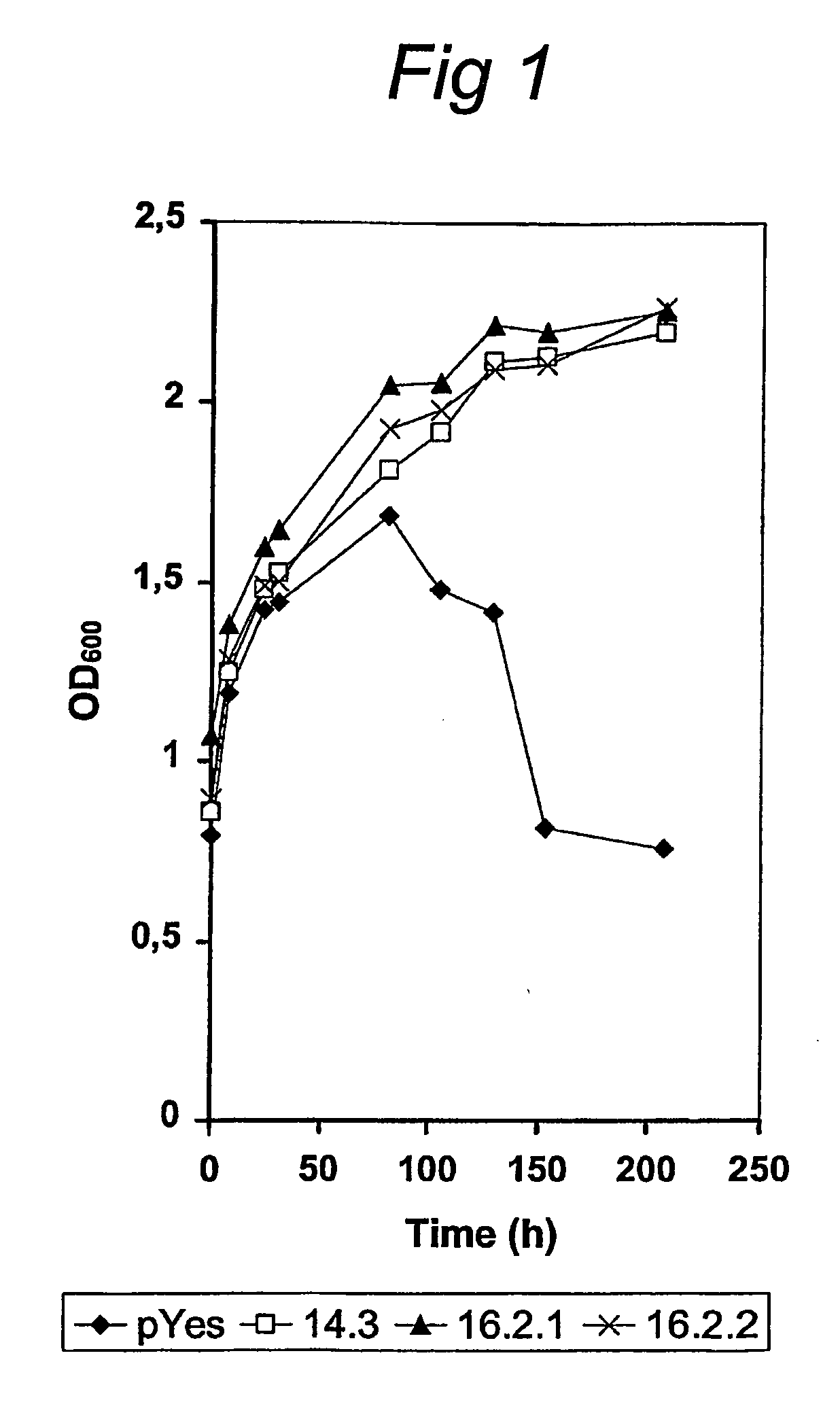Fermentation of pentose sugars
a pentose sugar and fermentation technology, applied in the field of host cells, can solve the problems of high cost, high pollution, and inability to use xylose as a carbon source,
- Summary
- Abstract
- Description
- Claims
- Application Information
AI Technical Summary
Benefits of technology
Problems solved by technology
Method used
Image
Examples
example 1
Cloning of Piromyces Xylanase Isomerase and Xylulose Kinase cDNAs
Organism and Growth Conditions
[0057]The anaerobic fungus Piromyces sp. E2 (ATCC 76762), isolated from faeces of an Indian elephant, was grown anaerobically under N2 / CO2 (80% / 20%) at 39° C. in medium M2 supplemented with various carbon sources (24). Carbon sources used were Avicel (microcrystaline cellulose type PH 105, Serva, Germany), fructose or xylose (all 0.5%, w / v). After growth ceased, as judged by hydrogen production, the cells were harvested by centrifugation (15,000×g, 4° C., 15 min;) or by filtration over nylon gauze (30 μm pore size).
Preparation of Cell-Free Extract
[0058]The fungal cells were washed with deionized water to remove medium components. Cell-free extracts were prepared by freezing the cells in liquid nitrogen and subsequent grinding with glass beads (0.10-0.11 mm diameter) in a mortar. Tris / HCl buffer (100 mM, pH 7.0) was added to the powder (1:1, w / v) and after thawing for 15 min t...
example 2
Construction of Yeast Expression Vectors
Expression of Xylose Isomerase from Piromyces sp. E2 in Saccharomyces cerevisiae
[0065]cDNA from Piromyces sp. E2 was used in a PCR reaction with pfu polymerase (Stratagene). The primers were designed using the sequences from the 5′ and 3′ ends of the xylose isomerase gene and also contained a Sfi I and a XbaI restriction site. The PCR product was cloned in the pPICZα vector (Invitrogen, Carlsbad, Calif., USA). To obtain the xylose isomerase gene, the pPICZα vector was digested with EcoRI and XbaI. The digestion product was ligated-into the pYes2 vector (Invitrogen). The pYes2 plasmid with the xylose isomerase gene was transformed into Saccharomyces cerevisiae (stam BJ1991, gift from Beth Jones, UvA). The genotype of this strain is: matα, leu2, trp1, ura 3-251, prb1-1122 and pep4-3.
[0066]Transformants were plated on SC plates (0.67% YNB medium+0.05% L-Leu+0.05% L-Trp+2% glucose+2% agarose). Untransformed cells can not grow on these...
example 3
Growth of Transformed Yeast Strains on Xylose
Medium Composition
[0068]Saccharomyces cerevisiae strains were grown on SC-medium with the following composition: 0.67% (w / v) yeast nitrogen base; 0.01% (w / v) L-tryptophan; 0.01% (w / v) L-leucine and either glucose, galactose or xylose, or a combination of these substrates (see below). For agar plates the medium was supplemented with 2% (w / v) bacteriological agar.
Growth Experiment
[0069]Saccharomyces cerevisiae strain BJ1991 (genotype: matα, leu2, trp1, ura 3-251, prb1-1122, pep4-3) transformed with pYes2 without insertion and three selected transformants (16.2.1; 16.2.2 and 14.3) containing pYes2 with the Piromyces sp. E2 xylose isomerase gene were grown on SC-agar plates with 10 mM glucose as carbon source. When colonies were visible, single colonies were used to inoculate liquid SVC-medium with 100 mM xylose and 25 mM galactose as carbon sources. Growth was monitored by measuring the increase in optical density at 600 nm on a ...
PUM
| Property | Measurement | Unit |
|---|---|---|
| Fraction | aaaaa | aaaaa |
| Fraction | aaaaa | aaaaa |
| Fraction | aaaaa | aaaaa |
Abstract
Description
Claims
Application Information
 Login to View More
Login to View More - R&D
- Intellectual Property
- Life Sciences
- Materials
- Tech Scout
- Unparalleled Data Quality
- Higher Quality Content
- 60% Fewer Hallucinations
Browse by: Latest US Patents, China's latest patents, Technical Efficacy Thesaurus, Application Domain, Technology Topic, Popular Technical Reports.
© 2025 PatSnap. All rights reserved.Legal|Privacy policy|Modern Slavery Act Transparency Statement|Sitemap|About US| Contact US: help@patsnap.com

